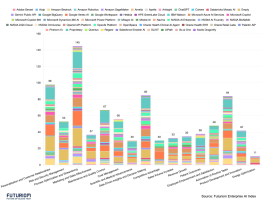NVIDIA Posts Solid Results Despite China Ban

NVIDIA posted strong quarterly results last night, despite taking charges against lost business in China and being cut off from what management believes to be a $50 billion total addressable market there. And tucked into the good news were some surprising details about AI deployments, networking, and the potential for future markets.
First, the basics: For NVIDIA’s first fiscal quarter 2026, revenues of $44 billion were up 69% year-over-year (y/y). Datacenter revenue of $39 billion grew 73% y/y, and 70% of those datacenter sales were attributed to NVIDIA’s new Blackwell chip technology, specifically the GB200. Adjusted net income was $20 billion, or 81 cents per share.
NVIDIA’s China Problem
The bad news, which management stressed throughout the earnings call, was about those export controls imposed by the Trump administration on NVIDIA’s H20 chips, which are stripped-down Hopper chips specially designed for the China market. New stringent licensing requirements have cut NVIDIA’s H20 line out of the market, though NVIDIA claims to be considering a Blackwell-based alternative that might meet the licensing requirements.
While NVIDIA saw $4.6 billion in H20 sales for the quarter before the ban went into effect on April 9, the company subsequently had to take a $4.5 billion charge for excess inventory and see another $2.5 billion in revenue lost from products that couldn’t be shipped. The situation impacted the company’s non-GAAP gross margin, which was 61%—but would have been 71.3% without the export control impacts. Further, second-quarter revenue guidance of $45 billion (plus or minus 2%) reflects about $8 billion of lost revenue.
NVIDIA Rages Against the Ruling
Management isn’t pulling its punches about the situation. “Losing access to the China AI accelerator market, which we believe will grow to nearly $50 billion, would have a material adverse impact on our business going forward and benefit our foreign competitors in China and worldwide,” said CFO Colette Kress on the call.
Still, in his remarks, NVIDIA CEO Jensen Huang maintained his positive stance on the U.S. administration, praising the move away from the so-called AI Diffusion Rule imposed by the Biden administration, which required extensive restrictions on the kinds of U.S.-made AI products that could be exported. “President Trump wants America to win,” Huang said.
Highlights of NVIDIA’s Quarter
Aside from the China market issue, NVIDIA’s earnings presentation contained a few interesting nuggets, as listed below:
Inferencing is a growth vector. Reasoning models are driving the growth of inferencing, NVIDIA maintains, and agentic AI is key to the future of intelligent applications. This, rather than generative AI, is the vector NVIDIA is tracking.
A boom in AI factory buildouts is coming. NVIDIA says hundreds of AI factories, or datacenters devoted specifically to generating AI, are being built, with many more yet to be announced. (Huang is set to be in Europe next week and there may be announcements there.) Every company will eventually have its own factory, Huang said.
Telcos will ramp AI factories of their own. While enterprise AI is just taking off, according to CEO Huang, telcos will not be far behind, as 6G networking will depend on AI.
Blackwell is driving most growth. The company’s latest chip architecture has driven performance and sales across all segments, including datacenter as noted above and gaming, which rose 42% y/y thanks to Blackwell.
NVIDIA is pushing its AI inferencing software, not just its chips. The company’s NeMo microservices framework is widely deployed, management said, to streamline the training of models. NVIDIA says NeMo speeds up model training time by 20% compared to other approaches. It cited dramatic improvements to model accuracy and response time for customers such as Cisco, Nasdaq, and Shell.
Networking grew substantially. After a disappointing last quarter, NVIDIA’s networking segment came roaring back with 64% sequential growth, thanks in no small part to the vendor’s latest NVLink technology, which NVIDIA claims provides 14X more bandwidth than PCIe Gen 5 and accounted for over $1 billion in sales for the quarter. NVIDIA also touted its success in the Ethernet market with the Spectrum-X switch, which management said now accounts for $8 billion in sales annually.
Sovereign AI infrastructure is surging. “Countries are racing to build national AI platforms to elevate their digital capabilities,” Huang said last night. He mentioned Taiwan, Sweden, Japan, Korea, India, Canada, France, the UK, Germany, Italy, and Spain as among the nations seeking to build their own government-sponsored AI factories based on NVIDIA chips. Not to mention the UAE and Saudi Arabia.
Hyperscalers remain top customers. In past quarters, investors have worried that NVIDIA is too reliant on the major cloud players for revenue. And it looks like that hasn’t changed. According to CFO Kress, the major hyperscalers are each deploying approximately 72,000 Blackwell GPUs per week and “are on track to further ramp output this quarter.”
NVIDIA's betting big on robotics. Robots are taking over manufacturing, Huang said, and every factory will have its own accompanying AI factory equipped with NVIDIA's Omniverse digital twin simulations.
Futuriom Take: Investors expect a lot from NVIDIA, and it continues to jump through every hoop. Despite headwinds from its ban from the China market, Blackwell is proving a solid growth engine, and the company plans multiple installations to meet a range of customer demands. We’ll see what the next few quarters produce.




















